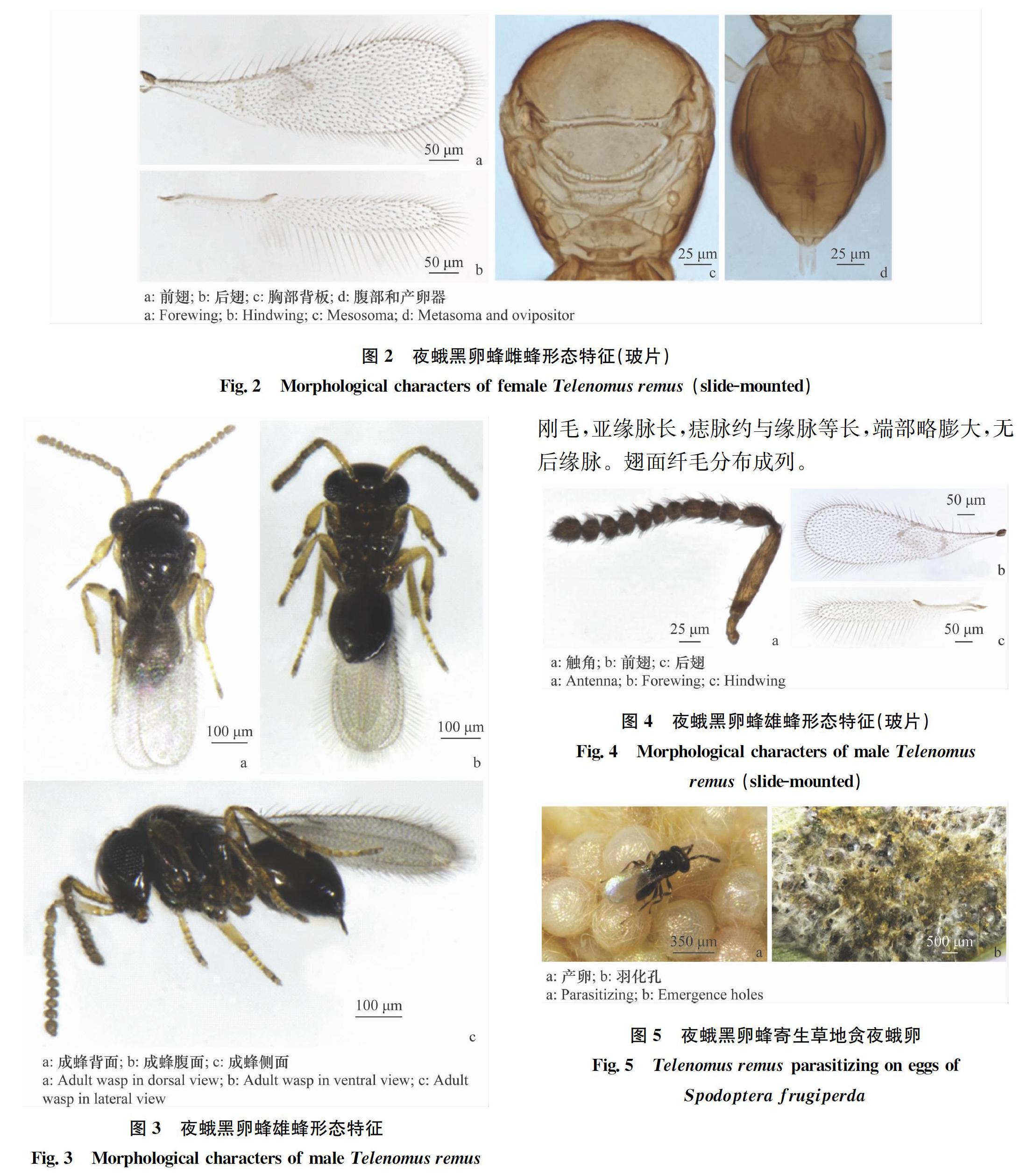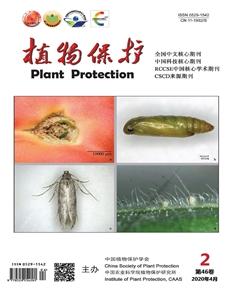草地贪夜蛾两种重要卵寄生蜂的鉴别及寄生行为
王竹红 葛均青 刘紫晶



摘要 草地贪夜蛾Spodoptera frugiperda (J.E.Smith)是世界重要农业害虫,具有很强的迁飞性,对玉米等禾本科植物造成危害。调查草地贪夜蛾卵寄生性天敌资源,明确其种类和鉴别特征,对筛选优势天敌种类和开展生物防治具有重要意义。对福建省寄生性天敌资源调查结果表明,福建省有两种草地贪夜蛾卵寄生蜂,分别为夜蛾黑卵蜂Telenomus remus Nixon和螟黄赤眼蜂 Trichogramma chilonis Ishii,本文记述了这两种卵寄生蜂的主要形态特征,并观察了其寄生行为。
关键词 草地贪夜蛾; 寄生蜂; 调查; 鉴别; 寄生行为
中图分类号: S 435.132 文献标识码: A DOI: 10.16688/j.zwbh.2019614
Abstract The fall armyworm, Spodoptera frugiperda, is one of the most important agricultural pests in the world. It has strong immigrating ability and causes harm to corn and Gramineae plants. Therefore, it is of great importance to further surveys and identification on parasitoid wasps of S. frugiperda egg for selection of superior natural enemies and field application. Through field surveys, two species of egg parasitoid wasps, Telenomus remus Nixon and Trichogramma chilonis Ishii were collected in Fujian province. The morphological characteristics and occurrence of parasitoid wasps were briefly recorded with the photographs of parasitoid wasps, and the parasitic behavior was also studied.
Key words Spodoptera frugiperda; parasitoids; investigation; identification; parasitic behavior
草地貪夜蛾Spodoptera frugiperda (J.E.Smith)隶属鳞翅目Lepidoptera,夜蛾科Noctuidae,又称秋黏虫(英文名fall armyworm),原产于美洲热带及亚热带地区,具有食性杂、繁殖能力强、迁飞扩散快、为害严重等特点[1-4]。2019年1月,草地贪夜蛾入侵我国云南省,仅历时9个月就已入侵我国25个省份,见虫面积100多万hm2,实际为害面积16.4万 hm2[5]。草地贪夜蛾将在我国西南、华南地区越冬定殖,成为我国又一个“北迁南回、周年循环”的重大迁飞性害虫,其发生和为害可能成为常态[5]。因此,加强草地贪夜蛾的监测与防控研究刻不容缓。
生物防治是害虫防治持续有效的方法。国外对草地贪夜蛾的生物防治研究主要集中于寄生性天敌,包括膜翅目和双翅目昆虫[6],其中,缘腹细蜂科Scelionidae的夜蛾黑卵蜂Telenomus remus Nixon是美洲、非洲、亚洲等地草地贪夜蛾重要的卵寄生蜂[7-10];茧蜂科Braconidae脊茧蜂属的Aleiodes laphygmae (Viereck)、悬茧蜂属的Meteorus laphygmae (Viereck)、内茧蜂属的Rogas vaughani (Muesebeck)和R. laphygmae (Viereck)、雕绒茧蜂属的Glyptapanteles creatonoti (Viereck)是幼虫期主要寄生蜂[10-13],甲腹茧蜂属寄生蜂Chelonus spp.是“卵-幼虫”兼性寄生蜂[14-15];姬蜂科Ichneumonidae齿唇姬蜂属的Campoletis grioti (Blanchard)、黑唇姬蜂C.sonorensis (Cameron)和棉铃虫齿唇姬蜂C.chlorideae Uchida是幼虫期主要寄生蜂[10-12];姬蜂科的Diapetimorpha introita (Cresson)是蛹期主要寄生蜂[12]。此外,赤眼蜂科Trichogrammatidae的赤眼蜂属Trichogramma spp.也是卵期寄生蜂[16-17]。这些寄生蜂在生物防治中发挥了重要作用,尤其是卵寄生蜂寄生率高,田间适应性强,被多个国家成功应用于草地贪夜蛾的生物防治[6,18-21]。
2019年5月,在福建省泉州市、南安市首先发现草地贪夜蛾入侵。之后,全省各地陆续发现草地贪夜蛾为害[22]。我们在福建各地进行了草地贪夜蛾寄生性天敌的调查,共采集到两种卵寄生蜂,分别为夜蛾黑卵蜂Telenomus remus Nixon和螟黄赤眼蜂Trichogramma chilonis Ishii。由于草地贪夜蛾是今年重大入侵害虫,及时进行监测和绿色防控势在必行。深入调查发掘、准确鉴定优势种天敌至关重要。本文在对福建省草地贪夜蛾寄生性天敌资源调查的基础上,重点研究了两种卵寄生蜂,夜蛾黑卵蜂和螟黄赤眼蜂的形态特征,提供了寄生蜂的形态特征照片;概述了目前草地贪夜蛾卵寄生蜂的种类;初步研究了两种卵寄生蜂的寄生行为,为进一步利用寄生性天敌开展草地贪夜蛾生物防治提供科学依据。
1 材料与方法
1.1 寄生性天敌调查
2019年8月-2019年10月在福建省多地采集草地贪夜蛾卵块,带回实验室饲养收集寄生蜂。先将羽化的寄生蜂进行拍照,然后连同采集标签放入100%乙醇中保存,待制作玻片标本和种类鉴定。
1.2 两种卵寄生蜂的主要形态特征和寄生行为
1.2.1 玻片标本制作
根据黄建[23]的方法进行玻片标本制作。
1.2.2 标本拍照
寄生蜂和寄主照片采用Nikon SMZ18体视镜(带Nikon DS-Ri2摄像头、NIS-Elements D软件)拍摄。玻片标本照片采用Nikon Ni微分干涉显微镜(带Nikon DS-Ri2摄像头、NIS-Elements D软件)拍摄。
1.2.3 种类鉴定
寄生蜂体长在未制作玻片标本前测量,其他形态特征则在玻片标本上进行测量。
1.2.4 夜蛾黑卵蜂和螟黄赤眼蜂的产卵行为观察
分别以草地贪夜蛾和斜纹夜蛾卵为寄主,体视镜下观察比较夜蛾黑卵蜂和螟黄赤眼蜂的产卵行为。室温条件下进行。
1.2.5 数据分析
利用SPSS 17.0 对数据进行比较分析。
2 结果与分析
共采集到草地贪夜蛾卵寄生蜂两种,分别为夜蛾黑卵蜂T. remus Nixon和螟黄赤眼蜂T. chilonis Ishii,对两种寄生蜂的主要鉴别特征记述如下。
2.1 夜蛾黑卵蜂Telenomus remus Nixon, 1937(图1~图5) Telenomus remus Nixon, 1937. Annals and Magazine of Natural History, 20: 444-475.
雌:体长0.5~0.6 mm,体亮黑色。触角暗褐色,足基节、腿节和胫节大部分暗褐色,转节、胫节基部小部分、跗节第1节或第1~4节褐黄色至稍暗色,跗节端部暗色。翅透明,前翅亚缘脉约2/3处下方具一不规则的浅烟褐色竖条纹,缘脉下方、痣脉内侧具一浅烟褐色云斑。
复眼具细毛。头横宽略大于胸宽,头顶散生细毛。触角11节,各节具较密的短毛。柄節长约为宽的5.52倍;梗节长于鞭节各节,约与棒节末节等长;索节5节,小,念珠状;棒节膨大,4节,各节长度比为2.3∶3.3∶3.4∶5.0。
胸部隆起,胸部背板密布细毛。中胸盾片两侧缘各具1个近三角形侧突;小盾片前缘两侧各具6~7个小齿,后缘及侧缘具脊,形成弧形念珠状;后胸背板中部具网状脊;并胸腹节两侧、气门下方具梯形或不规则形的块状脊,整体呈拱状。
前翅窄长,长为宽的3.20倍;缘毛为翅宽的0.42倍。亚缘脉长,具8根刚毛;缘脉短,约为亚缘脉长的0.16倍,约为痣脉长的0.57倍,具2~3根刚毛;后缘脉不发达。后翅细长,前后缘近平行,缘脉长,约为翅宽的1.54倍。
足跗节5-5-5。
腹部长梭形,稍长于胸部。第1、2节背板基部具纵脊沟,其余各节光滑;第2背板最长,为其后各节背板总和长的2.04倍。末节腹节的腹板不纵裂,产卵器从腹部末端伸出,侧面观与腹部纵向平行,通常产完卵后产卵器会缩回腹部内,再次产卵时又伸出。
雄:体色、形态结构、翅等十分近似雌性。但触角12节,且棒节不明显,整个鞭节呈线形念珠状(雌性触角11节,棒节膨大,4节);梗节长于鞭节各节,鞭节中末节相对最长且宽,触角各节具较密的短毛。足腿节和胫节相对浅褐色。雄性外生殖器从腹部末端朝腹向伸出,侧面观与腹部纵向呈一定角度(雌性产卵器从腹部末端伸出,侧面观与腹部纵向平行)。
2.2 螟黄赤眼蜂Trichogramma chilonis Ishii,1941(图6~图8) Trichogramma chilonis Ishii, 1941. Knotyu, 14: 169-176.
雄:体长0.35~0.40 mm。体暗黄色,中胸盾暗褐色,腹部黑褐色。翅透明,前翅基部到痣脉下方翅面大部分浅烟褐色,翅脉暗褐色。雄性外生殖器钩爪黑褐色。
触角5节;柄节长为宽的4.25倍;梗节长为宽的1.55倍;环节2节,小(第2环节通常不易看到);棒节1节(索节与棒节愈合),明显长于柄节与梗节之和,长为宽的6.31倍,具长毛,最长的毛为棒节宽的2.68倍。前翅阔圆,长为宽的1.86倍;缘毛为翅宽的0.14倍。翅脉呈“S”形弯曲,缘脉短,具约3根刚毛,亚缘脉长,痣脉约与缘脉等长,端部略膨大,无后缘脉。翅面纤毛分布成列。
足跗节3-3-3。
外生殖器:阳基背突三角形,端部较钝圆,具明显的半圆形侧叶,阳基背突末端达D(腹中突基部至阳基侧瓣末端距离)的约1/2;腹中突较大,约为D的0.48倍;中脊略长于D,成对;钩爪末端伸达D的1/2左右。阳茎与其内突约等长,两者全长约等于阳基长度。
雌:体长0.34~0.47 mm。体褐黄色,腹部暗黄色,约第2~3节具1暗褐色横带。翅透明,前翅基部到痣脉下方翅面大部分浅烟褐色,翅脉暗褐色。产卵器基部外侧各具1个小暗褐色斑。
触角7节;柄节长为宽的3.76倍,梗节长为宽的1.83倍,长于2节索节之和;环节2节,小(第2环节通常不易看到);索节2节,第1索节稍短于第2索节;棒节1节,粗长,长于梗节、环节和索节之和,从基向2/5到末端的腹面强烈斜截,具多个长条形感觉器。前翅阔圆,长为宽的1.98倍,其他特征基本类似雄性。
足跗节3-3-3。
产卵器第3产卵瓣短,约为第2负瓣片长的0.17倍。
从田间采集的草地贪夜蛾卵中饲养出来的螟黄赤眼蜂,有些个体发育不良,多为翅缩短变小(图7c)。同时,据林乃铨记述,在不同温度条件下培养出来的螟黄赤眼蜂雌成虫体色有差异[24]。
2.3 草地贪夜蛾卵、卵-幼虫寄生蜂种类
据国内外文献报道,草地贪夜蛾的卵寄生蜂有缘腹细蜂科Scelionidae的1种,赤眼蜂科Trichogrammatidae的7种;卵、卵-幼虫寄生蜂有茧蜂科Braconidae的4种(表1)。卵-幼虫寄生蜂为卵-幼虫跨期寄生,寄生蜂产卵在寄主卵中,寄主卵孵化为幼虫后,寄生蜂卵才孵化,在寄主幼虫体内完成寄生蜂幼虫发育。
2.4 夜蛾黑卵蜂和螟黄赤眼蜂的产卵行为观察
夜蛾黑卵蜂和螟黄赤眼蜂的寄生行为都可以分为搜寻、检测、产卵、清理等几个过程。起初均是以触角敲击搜寻寄主,发现寄主后,用触角敲击寄主卵表面进行检测,此时往往会围绕卵表面转圈试探,夜蛾黑卵蜂检测寄主圈数往往超过一圈,而螟黄赤眼蜂检测时间较短,绕卵表面爬行不到一圈即可确定是否产卵。确认好寄主后,两种蜂都会掉转身,伸出产卵针插入寄主卵中,后足支撑身体,将卵产入寄主体内。螟黄赤眼蜂产卵时腹部末端有规律地伸缩,产卵时有时将产卵器拔出一部分后再以不同角度插回寄主卵中,可在相同或不同寄主卵块上多次产卵,并且产卵时间较检测时间长。产卵结束后,拔出产卵针,清理。分别以草地贪夜蛾和斜纹夜蛾卵为寄主,比较了夜蛾黑卵蜂和螟黄赤眼蜂的寄生行为,对检测时间、检测圈数、产卵时间等[40]进行观察记录,发现这两种蜂的检测时间、检测寄主圈数和产卵时间并无显著差异(表2)。
3 讨论
卵寄生蜂是草地贪夜蛾寄生性天敌中重要的寄生蜂类群,主要有夜蛾黑卵蜂和赤眼蜂,还有茧蜂科的一些“卵-幼虫”跨期寄生蜂。
夜蛾黑卵蜂是草地贪夜蛾重要的卵寄生蜂之一, 寄生多种鳞翅目害虫,尤其是夜蛾科害虫的卵[41],能将害虫消灭在卵期,从而降低幼虫对作物的为害[25-29]。1937年,Nixon首次发现并描述了该蜂[42]。夜蛾黑卵蜂可利用草地贪夜蛾或其他夜蛾科寄主卵大量繁殖后进行田间释放应用[43],是一种非常有潜力的寄生蜂。目前,利用夜蛾黑卵蜂防治草地贪夜蛾的技术日趋成熟,美国、巴西、墨西哥、委内瑞拉等国家均取得了显著的防治效果[7-10,19,21,43]。自2019年草地贪夜蛾入侵我国以来,已报道在广东、香港、贵州等地从草地贪夜蛾卵中调查采集到夜蛾黑卵蜂[33,44-45]。本研究在福建各地调查也发现寄生草地贪夜蛾的夜蛾黑卵蜂,且可以寄生草地贪夜蛾整个卵块,寄生蜂种群数量大,是控制草地贪夜蛾很好的卵寄生蜂資源。
据报道,寄生草地贪夜蛾卵的赤眼蜂有7种(表1),均属于赤眼蜂属Trichogramma,其中T. pretiosum (Riley)是草地贪夜蛾防治应用中研究较多的一种赤眼蜂[16,26,28,32,35,37]。夜蛾黑卵蜂可寄生整个寄主卵块,但赤眼蜂仅能寄生寄主卵块的上部卵[26]。目前,我国广东[33]、香港[33]等地已从草地贪夜蛾卵中调查采集到螟黄赤眼蜂。本研究调查发现,从田间草地贪夜蛾卵中采集到的螟黄赤眼蜂种群数量明显少于夜蛾黑卵蜂。因此,这两种卵寄生蜂在田间的种群竞争情况尚需进一步研究。
“卵-幼虫”寄生蜂产卵在寄主卵中,因此有人也将它列入卵寄生蜂类群中。但这类寄生蜂的卵在寄主卵孵化为幼虫后才开始孵化,并随着寄主幼虫的发育一起发育,而甲腹茧蜂(茧蜂科Braconidae,甲腹茧蜂亚科Cheloninae)的卵产入寄主的卵中,差不多到寄主幼虫要化蛹时才开始它们的发育[46]。相比卵寄生蜂,“卵-幼虫”寄生蜂寄生后,寄主幼虫仍可以继续造成危害,是该类寄生蜂不足之处。甲腹茧蜂属的Chelonus cautus和C.insularis曾被报道是草地贪夜蛾的“卵-幼虫”寄生蜂[14-15,38-39],而C. antillarum和C.formosanus也曾被报道是草地贪夜蛾的卵寄生蜂[34],根据甲腹茧蜂的寄生习性[46],后两种甲腹茧蜂可能也是“卵-幼虫”寄生蜂。
本文在调查与鉴别草地贪夜蛾两种卵寄生蜂的基础上对其寄生行为进行了初步研究,其他生物学特性及防治应用尚在进一步研究中。
参考文献
[1] SPARKS A N. A review of the biology of the fall armyworm[J]. The Florida Entomologist, 1979, 62(2): 82-86.
[2] JOHNSON S J. Migration and the life history strategy of the fall armyworm, Spodoptera frugiperda in the Western Hemsphere [J]. Insect Science and its Applications,1987,8:543-549.
[3] ASHLEY T R, WISEMAN B R, DAVIS F M, et al. The fall armyworm: a bibliography[J]. Florida Entomologist, 1989, 72(1): 152-202.
[4] 杨普云, 朱晓明, 郭井菲, 等. 我国草地贪夜蛾的防控对策与建议[J]. 植物保护, 2019, 45(4): 1-6.
[5] 中华人民共和国农业农村部. 农业农村部就草地贪夜蛾防控工作举行新闻发布会[EB/OL].[2019-09-17]. http:∥www. moa. gov. cn/hd/zbft_news/cdtyefk/.
[6] 卢辉, 唐继洪, 吕宝乾, 等. 草地贪夜蛾的生物防治及潜在入侵风险[J]. 热带作物学报, 2019, 40(6): 1237-1244.
[7] KENIS M, DU PLESSIS H, VAN DEN BERG J, et al. Telenomus remus, a candidate parasitoid for the biological control of Spodoptera frugiperda in Africa, is already present on the continent [J]. Insects, 2019, 10(4): 1-10.
[8] DE QUEIROZ A P, DE FREITAS BUENO A, POMARI-FERNANDES A, et al. Influence of host preference, mating, and release density on the parasitism of Telenomus remus (Nixon) (Hymenoptera, Platygastridae)[J]. Revista Brasileira de Entomologia, 2017, 61: 86-90.
[9] GAZIT Y, LEWIS W J, TUMLINSON J H. Arrestment of Telenomus remus(Hymenoptera: Scelionidae) by a kairomone associated with eggs of its host, Spodoptera frugiperda (Lepidoptera: Noctuidae) [J].Biological Control,1996,6:283-290.
[10] SHYLESHA A N, JALALI S K, ANKITA G, et al. Studies on new invasive pest Spodoptera frugiperda (J.E.Smith) (Lepidoptera: Noctuidae) and its natural enemies [J]. Journal of Biological Control, 2018, 32(3): 1-7.
[11] WYCKHUYS K A G, ONEIL R J. Population dynamics of Spodoptera frugiperda Smith (Lepidoptera: Noctuidae) and associated arthropod natural enemies in Honduran subsistence maize [J]. Crop Protection, 2006, 25(11): 1180-1190.
[12] MEAGHER R L, NUESSLY G S, NAGOSHI R N, et al. Parasitoids attacking fall armyworm (Lepidoptera: Noctuidae) in sweet corn habitats [J]. Biological Control, 2016, 95: 66-72.
[13] RUZ-NJERA R E, MOLINA O J, CARPENTER J E, et al. Survey for hymenopteran and dipteran parasitoids of the fall armyworm (Lepidoptera: Noctuidae) in Chiapas, Mexico[J]. Journal of Agricultural and Urban Entomology, 2007, 24: 35-42.
[14] JOURDIE V, ALVAREZ N, MOLINA-OCHOA J, et al. Population genetic structure of two primary parasitoids of Spodoptera frugiperda (Lepidoptera), Chelonus insularis and Campoletis sonorensis (Hymenoptera): to what extent is the host plant important?[J]. Molecular Ecology, 2010, 19(10): 2168-2179.
[15] MOLINA-OCHOA J, HAMM J J, LEZAMA-GUTIRREZ R, et al. A survey of fall armyworm (Lepidoptera: Noctuidae) parasitoids in the mexican states of michoacán, colima, jalisco, and tamaulipas [J]. Florida Entomologist, 2001, 84(1): 31-36.
[16] DE FREITAS BUENOR C O, DE FREITAS BUENO A, POSTALLI PARRA J R, et al. Biological characteristics and parasitism capacity of Trichogramma pretiosum Riley (Hymenoptera, Trichogrammatidae) on eggs of Spodoptera frugiperda (J.E.Smith) (Lepidoptera, Noctuidae)[J]. Revista Brasileira de Entomologia, 2010, 54(2): 322-327.
[17] DEQUECH S T B, CAMERA C, STURZA V S, et al. Population fluctuation of Spodoptera frugiperda eggs and natural parasitism by Trichogramma in maize [J]. Acta Scientiarum: Agronomy, 2013, 35(3): 295-300.
[18] MARTINEZ G A, BECERRA T A, BRAVO L X B.Biological control of Spodoptera frugiperda eggs using Telenomus remus Nixon in maize-bean-squash polyculture [J]. American Journal of Agricultural and Biological Sciences, 2012, 7: 285-292.
[19] FIGUEIREDO M L C, LUCIA D T, CRUZ I. Effect of Telenomus remus Nixon (Hymenoptera: Scelionidae) density on control of Spodoptera frugiperda (Smith) (Lepidoptera: Noctuidae) egg masses upon release in maize field [J]. Revista Brasileira de Milho E Sorgo, 2002, 1: 12-19.
[20] CARNEIRO T R, FERNANDES O A, CRUZ I. Influence of females intraspecific completion and lack of host on Telenomus remus Nixon (Hymenoptera: Scelionidae) parasitism on Spodoptera frugiperda(Smith) (Lepidoptera: Noctuidae) eggs[J].Revista Brasileira de Entomologia,2009,53(3):457-460.
[21] CAVE R D. Biology, ecology and use in pest management of Telenomus remus[J]. Biocontrol News and Information, 2000, 21: 21-26.
[22] 加強草地贪夜蛾的监测工作(南靖县2019年第8期)[EB/OL]. http:∥www. fujian. gov. cn/xw/ztzl/yjgl/yjxx/zrzhl/nyyhsw/201906/t20190610_4895367. htm.
[23] 黄建. 中国蚜小蜂科分类[M]. 重庆: 重庆出版社, 1994.
[24] 林乃铨. 中国赤眼蜂分类(膜翅目: 小蜂总科)[M]. 福州: 福建科学技术出版社, 1994.
[25] PEAFLOR M F G V, DE MORAES SARMENTO M M, DA SILVA C S B, et al. Effect of host egg age on preference, development and arrestment of Telenomus remus (Hymenoptera: Scelionidae) [J]. European Journal of Entomology, 2012, 109: 15-20.
[26] GOULART M M P, DE FREITAS BUENO A, DE FREITAS BUENO R C O, et al. Interaction between Telenomus remus and Trichogramma pretiosum in the management of Spodoptera spp.[J]. Revista Brasileira de Entomologia, 2011, 55(1): 121-124.
[27] PEAFLORM F G V, ERB M, MIRANDA L A, et al. Herbivore-induced plant volatiles can serve as host location cues for a generalist and a specialist egg parasitoid[J]. Journal of Chemical Ecology, 2011, 37: 1304-1313.
[28] DE SOUZA TAVARES W, CRUZ I, PETACCI F, et al. Potential use of Asteraceae extracts to control Spodoptera frugiperda(Lepidoptera: Noctuidae) and selectivity to their parasitoids Trichogramma pretiosum (Hymenoptera: Trichogrammatidae) and Telenomus remus (Hymenoptera: Scelionidae)[J]. Industrial Crops and Products, 2009, 30: 384-388.
[29] POMARI-FERNANDES A, DE QUEIROZ A P, DE FREITAS BUENO A, et al. The importance of relative humidity for Telenomus remus (Hymenoptera: Platygastridae) parasitism and development on Corcyra cephalonica (Lepidoptera: Pyralidae) and Spodoptera frugiperda (Lepidoptera: Noctuidae) eggs [J]. Annals of the Entomological Society of America, 2015, 108(1): 11-17.
[30] HOBALLAH M E, DEGEN T, BERGVINSON D, et al. Occurrence and direct control potential of parasitoids and predators of the fall armyworm (Lepidoptera: Noctuidae) on maize in the subtropical lowlands of Mexico[J]. Agricultural and Forest Entomology, 2004, 6(1): 83-88.
[31] MORALES J, VSQUEZ C, PREZ BN L, et al. Especies de Trichogramma (Hymenoptera: Trichogrammatidae) parasitoides de huevos de lepidópterosen el Estado Lara, Venezuela[J]. Neotropical Entomology, 2007, 36(4): 542-546.
[32] BESERRA E B, DIAS C T, PARRA J R P. Behavior of Trichogramma atopovirilia Oatman & Platner and T. pretiosum Riley (Hymenoptera: Trichogrammatidae) on Spodoptera frugiperda (J.E.Smith) (Lepidoptera: Noctuidae) egg [J]. Brazilian Journal of Biology, 2005, 65(1): 9-17.
[33] 李志刚,吕欣,押玉柯,等.粤港两地田间发现夜蛾黑卵蜂与螟黄赤眼蜂寄生草地贪夜蛾[J].环境昆蟲学报,2019,41(4): 760-765.
[34] MOLINA-OCHOA J, CARPENTER J E, HEINRICHS E A, et al. Parasitoids and parasites of Spodoptera frugiperda (Lepidoptera: Noctuidae) in the americas and caribbean basin: an inventory [J]. Florida Entomologist, 2003, 86(3): 254-289.
[35] DAZ M F, RAMíREZ A, POVEDA K. Efficiency of different egg parasitoids and increased floral diversity for the biological control of noctuid pests [J]. Biological Control, 2012, 60(2): 182-191.
[36] YOUNG J R, HAMM J J. Reproduction of Trichogramma fasciatum in eggs from tepa-sterilized fall armyworms[J]. Journal of Economic Entomology, 1967, 60(3): 723-724.
[37] CARNEIROT R, FERNANDESO A.Interspecific interaction between Telenomus remus (Hymenoptera: Platygastridae) and Trichogramma pretiosum (Hymenoptera: Trichogrammatidae) on Spodoptera frugiperda (Lepidoptera: Noctuidae) eggs[J]. Anais da Academia Brasileira de Ciências, 2012, 84(4): 1127-1135.
[38] RAJAPAKSERH S, WADDILLVAN H, ASHLEYT R. Effect of host age, parasitoid age and temperature on interspecific competition between Chelonus insularis Cresson, Cotesia marginiventris Cresson and Microplitis manila Ashmead [J]. International Journal of Tropical Insect Science, 1992, 13(1): 87-94.
[39] JOURDIEV, VIRLAE, MURILLO H, et al. Phylogeography of Chelonus insularis (Hymenoptera: Braconidae) and Campoletis sonorensis (Hymenoptera: Ichneumonidae), two primary neotropical parasitoids of the fall armyworm (Lepidoptera: Noctuidae) [J]. Annals of Entomological Society of America, 2010, 103(5): 742-749.
[40] 李元喜, 罗晨, 周长青, 等. 烟粉虱两种寄生蜂生物学特性及寄主竞争关系研究[J]. 昆虫学报, 2008, 51(7): 738-744.
[41] 唐雅丽, 陈科伟, 许再福. 夜蛾黑卵蜂(Telenomus remus Nixon)个体发育研究[J]. 长江蔬菜, 2010(18): 1-3.
[42] NIXON G E J. LIV.-Some Asiatic Telenomin (Hym., Proctotrupoidea)[J]. Annals and Magazine of Natural History, 1937, 10: 444-475.
[43] POMARI A F, BUENO A D, BUENO R, et al. Releasing number of Telenomus remus Nixon (Hymenoptera: Platygastridae) against Spodoptera frugiperda Smith (Lepidoptera: Noctuidae) in corn, cotton and soybean[J]. Ciência Rural, 2013, 43: 377-382.
[44] 霍梁霄, 周金成, 宁素芳, 等. 夜蛾黑卵蜂寄生草地贪夜蛾和斜纹夜蛾卵的生物学特性[J]. 植物保护,2019,45(6):60-64.
[45] 杨帅, 张龙喜, 赵旭, 等. 夜蛾黑卵蜂雌、雄蜂鉴别方法及雌蜂寄生草地贪夜蛾卵的行为特征[J]. 植物保护,2020,46(1):55-58.
[46] 何俊华. 浙江蜂类志[M]. 北京: 科学出版社, 2004.
(责任编辑: 杨明丽)

